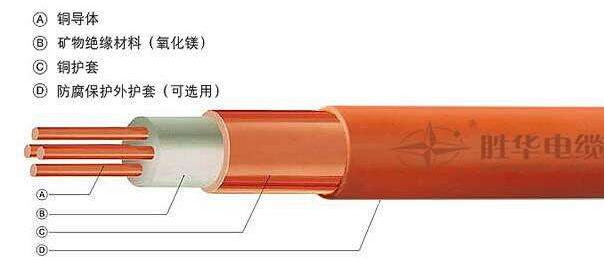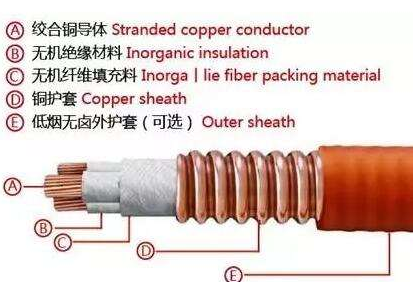Send Time:2019-3-13
The legendary mineral insulation cable is like this.
Source: Cable recruitment network
Mineral insulated cable is a cable that wraps copper conductor core lines with copper sheaths and uses magnesium oxide powder as inorganic insulating material to separate conductors and sheaths. The outermost layer can select appropriate protection covers as needed. Commonly known as MICC or MI cable. There is a similar cable that uses metal instead of copper sheaths to wrap core wires and insulation materials, called mineral insulated metal sheaths.

Mineral insulation cable
According to the structure can be divided into rigid and flexible. According to the standard can be divided into national standard cable(rigid) and enterprise cable(flexible). Only rigid mineral cables have national old standards. As the name implies, they are extremely difficult to bend, and transportation and installation have great limitations. Flexible mineral cables have standards set by various companies. The standards of each manufacturer are not the same, and the quality is uneven.
There are only six models of national standard cables: BTTQ, BTTVQ, WD-BTTYQ with a light load of 500V, and BTTZ, BTTVZ, and WD-BTTYZ with a heavy load of 750V.
With the exception of the national standard cable(rigid), all other flexible mineral cables are bid.
Relatively speaking, the standard cable technology is high, and the construction is complex and rigorous. Because the metal sheath itself is extremely difficult to bend, the difficulty of installation is the highest, and expensive special accessories are required. The fire protection performance is also the highest BS6387; The flexible cable installation is similar to that of ordinary cables, and the construction threshold is low. However, the fire protection performance is the same as that of BS6387. Among the applications, the products are mainly selected according to the fire protection level and importance of the building.

Mineral insulation cable
Rigid mineral cables can not be produced for a long period of time due to process restrictions, and special accessories are used for installation, and special tool toasters, bending wheels, etc. can be used for installation of bending radius(6D). Flexible mineral cables can be continuously produced, and different metal sheath structures have different bending properties. Domestic processes mainly include copper pipes(rigid), aluminum tubes, cross-welded corrugated copper pipes, and interlocking armored metal sheaths, allowing the bending radius to decrease in turn. The minimum is only 7D(D is the outer diameter of the cable, and the bending radius of the ordinary cable is about 10D). The actual site and cable bridge frame restrictions should be considered in the design and construction, and suitable products should be selected. In general, the smaller the allowable bending radius, the less difficult the installation.
Rigid mineral cables themselves are relatively hard, and the same impact resistance is also very strong. Flexible mineral cable is relatively flexible, and the ability to resist impact depends on the specific structure of the corresponding cable. However, all mineral cables except the interlocking type are difficult to fit through curved pipelines, especially large-size cables.
advantage
Since all the material of this cable is inorganic material, it has some advantages that other cables can not have.
Mineral insulation cable

1, fire resistance
The two materials used in mineral insulation cables are copper and mineral insulation. Such cables will not burn, nor will they ignite, and they can continue to operate under conditions close to the flame. The copper sheath melts at 1083 °C.
2, high operating temperature
Mineral insulated cables can withstand continuous operating temperatures up to 250 °C. Moreover, in an emergency, the cable can continue to operate at a temperature close to the melting point of the copper sheath for a short period of time.
3, long life
The inorganic materials used in mineral insulation cables can ensure that the cables have stability, long life and fire resistance.
4, explosion-proof
A highly compacted insulating material in a mineral insulated cable that prevents steam, gas, and flame from passing between parts of the equipment connected to the cable.
5, small outer diameter
Mineral insulated cables are smaller in diameter than other cables with the same rated current.
6, waterproof
If the mineral insulation cable is completely immersed in water, the mineral insulation cable can continue to operate with its seamless metal sheath.
7, high mechanical strength
Mineral insulated cables are durable and can withstand severe mechanical damage without compromising their electrical properties.
8, large load flow
For cables of the same cross-section, mineral insulated cables transmit higher currents than other types of cables. At the same time, mineral insulated cables can also tolerate considerable overload.
9, short circuit fault rating
At the same temperature, the short-circuit fault rating of mineral insulated cables is significantly higher than that of other types of cables.
10, grounding
For mineral insulated cables, independent grounding wires are not required because the copper sheath used for this cable has served as a grounding wire and can provide good low grounding resistance. As far as the grounding skin protection loop(ESR) wiring is concerned, in the MEN(multi-ground neutral) system, the outer copper sheath can be used as a ground and neutral conductor.
11, high corrosion resistance
The copper jacket of the mineral insulated cable is highly resistant to corrosion and for most devices it does not require additional protection. In areas where the copper cover of the cable is vulnerable to chemical corrosion or industrial contamination, a plastic outer cover should be used to protect the mineral insulation cable.
欢迎咨询
我们会尽快联系您
